On This Page:

Background
Cancers can be diagnosed at different stages in their development. Stage of cancer diagnosis may be expressed as numbers (for example, I, II, III, or IV) or by terms such as “localized,” “regional,” and “distant.” The lower the number or the more localized the cancer, the better a person’s chances of benefiting from treatment.
Tracking the rates of late-stage (distant) cancers is a good way to monitor the impact of cancer screening. When more cancers are detected in early stages, fewer should be detected in late stages.
Both rates of late stage disease and stage proportions are provided below since each has a somewhat different interpretation. For example, rates could be declining among all stages of disease, but the proportion of late stage disease among diagnosed cases could be relatively constant.
Measure
Late-stage diagnosis rate: The number of new cancer cases diagnosed at a distant stage per 100,000 people per year for cancers of the prostate, lung and bronchus, colon, rectum, and cervix uteri. Late stage is defined as regional and distant stage diagnoses, per 100,000 women per year for cancer of the female breast. Late stage is defined as the stages which screening tends to reduce and differs by cancer site (i.e. when screening is initiated the proportion diagnosed with late state disease goes down).
Stage Distribution: The proportion of new cancer cases among all cases diagnosed in a specific year. The full distribution of all stages (local, regional, distant and unstaged/unknown) is shown.
Trend lines: calculated from the underlying rates using the Joinpoint Trend Analysis Software.
The 2020 incidence rate is displayed but not used in the fit of the trends line(s). Impact of COVID on SEER Incidence 2020 data.
Data Source
SEER Program, National Cancer Institute, 2004–2022.
Healthy People 2030 Target
- There are no Healthy People Target for breast, colon, rectum, cervix uteri, lung and bronchus or prostate cancer by stage at diagnosis.
Healthy People 2030 is a set of goals set forth by the Department of Health and Human Services.
Trends and Most Recent Estimates
- Late Stage Female Breast Cancer Rates
-
Rates of new cases of late stage female breast cancer, delay-adjusted incidence, 2004-2022 Overview Graph Detailed Trend Graphs Most Recent Estimates (2022) Delay Rate per 100,000 95% Confidence Interval 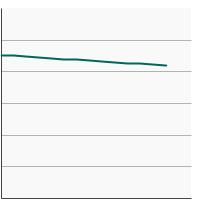

Late Stage Breast Cancer 
44.6 44.1 - 45.0 - Distant Stage Cancer Rates
-
Rates of new cancers of distant stage diseases, delay-adjusted incidence, 2004-2022 Overview Graph Detailed Trend Graphs Most Recent Estimates (2022) Delay Rate per 100,000 95% Confidence Interval 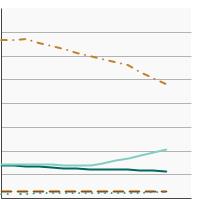

Colon 
6.1 6.0 - 6.3 Rectum 
1.8 1.8 - 1.9 Cervix Uteri 
1.3 1.2 - 1.3 Lung and Bronchus 
21.1 20.9 - 21.3 Prostate 
13.9 13.6 - 14.1 - Stage Distribution
-
- Female Breast Cancer
-
Distribution of female breast cancer diagnoses by stage at diagnosis, 2004-2022 Overview Graph Detailed Trend Graphs Most Recent Estimates (2022) Percent of diagnoses 95% Confidence Interval 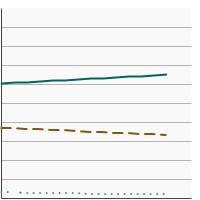

Localized 
66.4 66.1 - 66.7 Regional/Distant 
31.0 30.8 - 31.3 Unstaged/Unknown 
2.6 2.5 - 2.7 - Lung Cancer
-
Distribution of lung cancer diagnoses by stage at diagnosis, 2004-2022 Overview Graph Detailed Trend Graphs Most Recent Estimates (2022) Percent of diagnoses 95% Confidence Interval 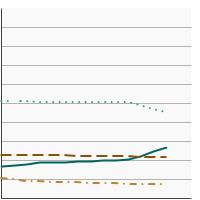

Localized 
29.5 29.2 - 29.8 Regional 
19.6 19.3 - 19.9 Distant 
45.1 44.8 - 45.5 Unstaged/Unknown 
5.8 5.6 - 6.0 - Colon Cancer
-
Distribution of colon cancer diagnoses by stage at diagnosis, 2004-2022 Overview Graph Detailed Trend Graphs Most Recent Estimates (2022) Percent of diagnoses 95% Confidence Interval 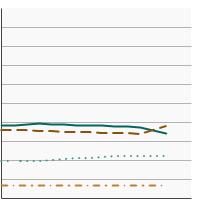

Localized 
33.8 33.4 - 34.3 Regional 
35.8 35.4 - 36.3 Distant 
23.4 23.0 - 23.8 Unstaged/Unknown 
7.0 6.7 - 7.2 - Rectum Cancer
-
Distribution of rectum cancer diagnoses by stage at diagnosis, 2004-2022 Overview Graph Detailed Trend Graphs Most Recent Estimates (2022) Percent of diagnoses 95% Confidence Interval 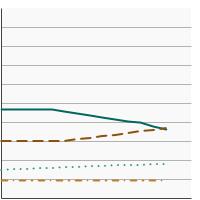

Localized 
38.6 37.9 - 39.4 Regional 
33.8 33.1 - 34.5 Distant 
18.9 18.4 - 19.5 Unstaged/Unknown 
8.6 8.2 - 9.1 - Cervix Uteri Cancer
-
Distribution of cervix uteri cancer diagnoses by stage at diagnosis, 2004-2022 Overview Graph Detailed Trend Graphs Most Recent Estimates (2022) Percent of diagnoses 95% Confidence Interval 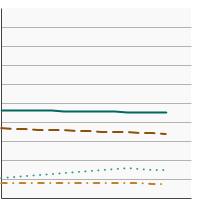

Localized 
38.6 37.4 - 39.9 Regional 
37.3 36.1 - 38.5 Distant 
17.6 16.6 - 18.5 Unstaged/Unknown 
6.5 5.9 - 7.1 - Prostate Cancer
-
Distribution of prostate cancer diagnoses by stage at diagnosis, 2004-2022 Overview Graph Detailed Trend Graphs Most Recent Estimates (2022) Percent of diagnoses 95% Confidence Interval 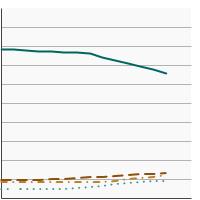

Localized 
70.3 70.0 - 70.5 Regional 
13.3 13.1 - 13.5 Distant 
9.1 9.0 - 9.3 Unstaged/Unknown 
7.3 7.1 - 7.4
Additional Information
- Cancer Staging. National Cancer Institute.
- Metastatic Cancer. National Cancer Institute.
- Tumor Grade. National Cancer Institute.
- Tumor Markers. National Cancer Institute.
- Understanding Laboratory Tests. National Cancer Institute.
- Staging. American Cancer Society.
- Resources for Health Professionals. National Cancer Institute.
- SEER Program Coding and Staging Manual 2018. National Cancer Institute.
- Annual Report to the Nation on the Status of Cancer. National Cancer Institute.
- SEER Cancer Stat Facts: Breast Cancer. National Cancer Institute.
- SEER Cancer Stat Facts: Cervix Uteri Cancer. National Cancer Institute.
- SEER Cancer Stat Facts: Colon and Rectum Cancer. National Cancer Institute.
- SEER Cancer Stat Facts: Lung and Bronchus Cancer. National Cancer Institute.
- SEER Cancer Stat Facts: Prostate Cancer. National Cancer Institute.